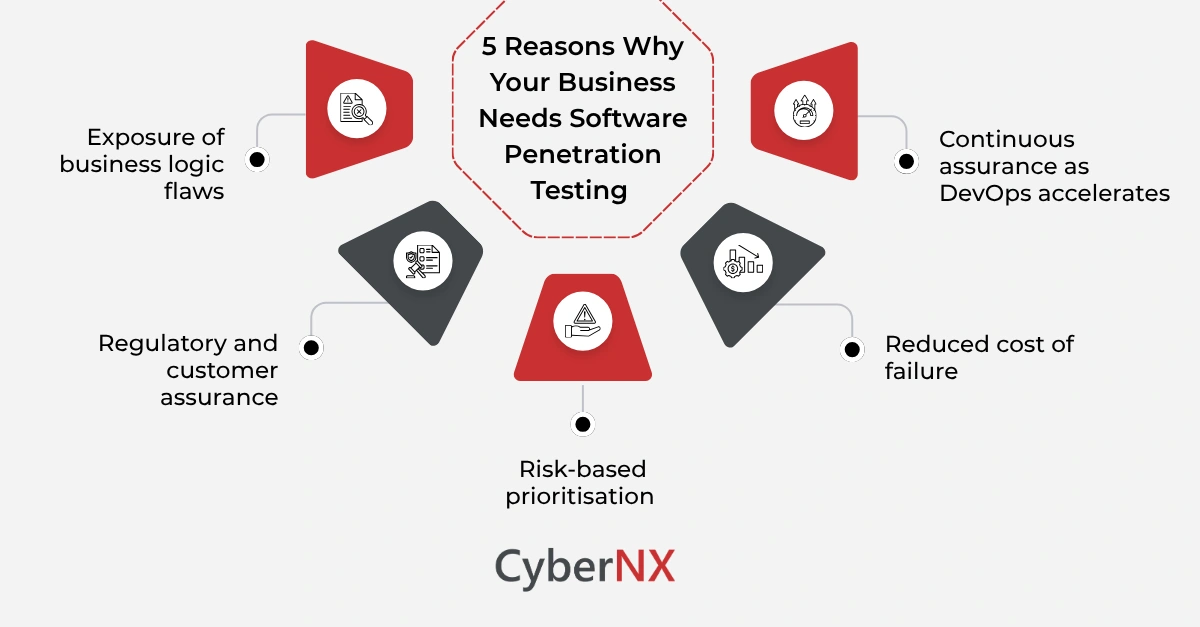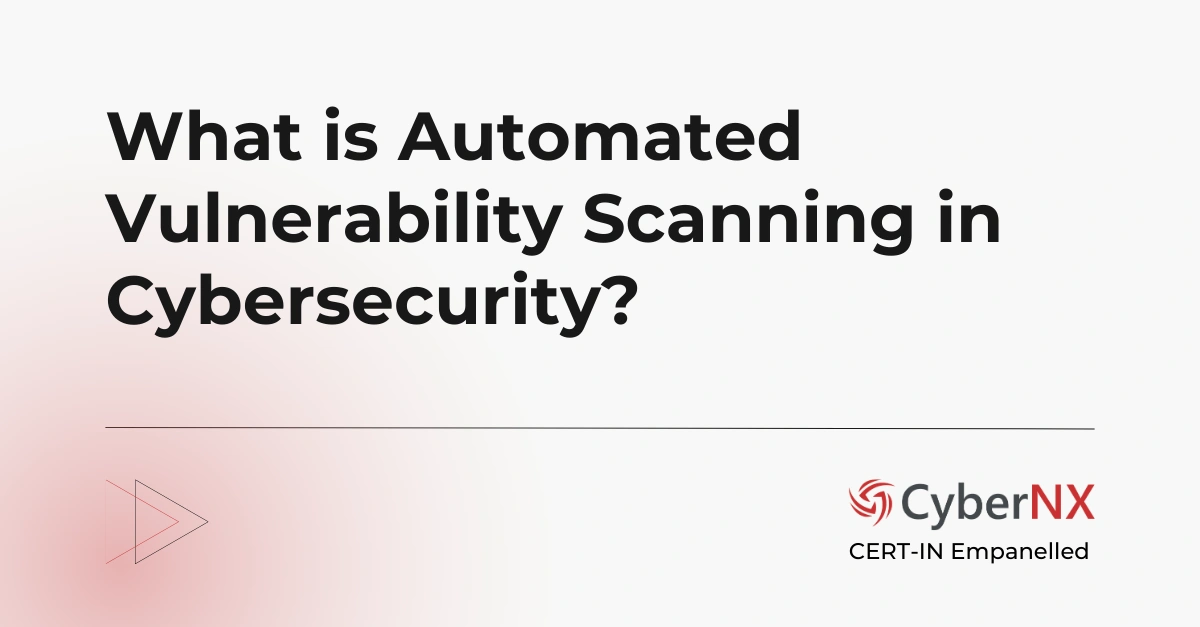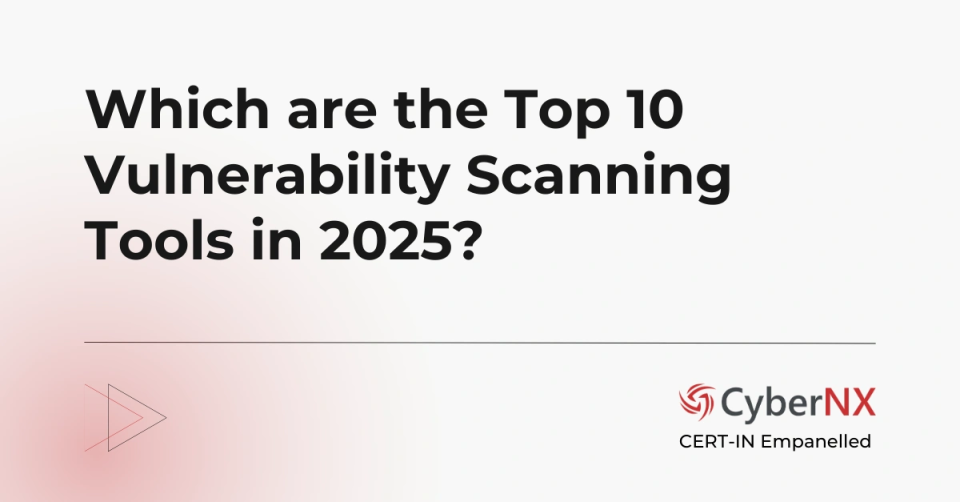Many organisations build applications rapidly, deploy into production, and then discover costly vulnerabilities too late. We’ve seen this happening repeatedly in the market. Such loopholes lead to data leaks, disrupted operations and reputation damage. That’s why software penetration testing shouldn’t be seen as a check-box exercise. It is a proactive step for software developers to find and fix weaknesses before attackers exploit them.
In this guide, we walk through what software penetration testing involves, how you should approach it and the common challenges.
What is software penetration testing?
Software penetration testing means simulating real-world attacks on your software (applications, APIs, back-end logic) to identify exploitable vulnerabilities. Unlike standard vulnerability scanning, which often produces large lists of issues with uncertain exploitability, penetration testing breathes life into risk by showing how a weakness can be exploited.
In effect: you’re hiring or simulating the attacker (in a controlled way) and asking: if they tried, could they break in? Then you use that information to fix the path.
For decision-makers such as CISOs and software heads, the value is clearer insight into weakest links, more confident release decisions, and fewer surprises in production crises.
Why your organisation needs software penetration testing
Here, we unpack the motivations and value businesses often see when they opt for software penetration testing.
1. Exposure of business logic flaws
Automated tools often miss subtle design vulnerabilities – things like authentication bypass, horizontal privilege escalation, or chained weaknesses in API flows. A penetration test surfaces these.
2. Regulatory and customer assurance
Many frameworks (e.g., PCI Security Standards Council’s guidance) include penetration testing as a requirement.
3. Risk-based prioritisation
Rather than treating all code defects equally, penetration testing gives you exploitability context – what an attacker can do. That aligns with business risk and helps you invest smartly.
4. Reduced cost of failure
Finding a critical flaw post-release is far costlier than discovering it pre-release. Testing early and often reduces production remediation, downtime or brand damage.
5. Continuous assurance as DevOps accelerates
With modern delivery models, many organisations push features rapidly. A robust software penetration testing programme helps keep velocity without sacrificing security.
Key challenges in software penetration testing
Every security lead will recognise these hurdles.
1. Scope ambiguity
Without a clear scope you may test only parts of your application and miss critical modules. A narrowly scoped test might look “clean” but leave large blind spots.
2. Fragmented architecture and visibility gaps
In microservices, cloud-native or hybrid environments, tracking all components is hard. If you leave out a public API, or a third-party integration, you leave the attacker a gap.
3. Tool-only mindset
Some teams rely on automated scanning tools alone. These are valuable – but they don’t simulate real attacker tactics. Penetration testing needs human creativity and context.
4. Resource and skill constraints
Skilled penetration testers are in demand. Organisations may struggle to staff or budget internal teams – and outsourcing needs good governance.
5. Remediation bottlenecks
The test is only half the job. If findings languish without proper fixes, you don’t reap the value. Without a feedback loop into development and QA, the test becomes yet another report collecting dust.
6. Mis-aligned expectations
Stakeholders might expect “everything will be perfect” or “no issues found”. But the reality is: finding issues is the success. You want meaningful findings, not a “no issues” certificate.
By understanding these challenges upfront, you can structure your programme to avoid them.
Software penetration testing lifecycle: step by step
A structured process is what helps while you test software. Here’s what it consists of:
1. Planning & scoping
Before any testing begins you must define objectives, asset inventory, risk profile, rules of engagement and timelines. Agree on what counts as in-scope and out-of-scope; what level of access testers have, whether live production systems are used or test environments.
Key questions:
- Which software modules, APIs, microservices are included?
- What environments: dev, QA, pre-prod, production?
- What user roles and scenarios will the test cover?
- What are your success criteria (e.g., no critical findings, exploit chain under 24h)?
- What data is off-limits or must not be impacted? Clear planning prevents surprises and ensures the test gives meaningful results.
Tip: Involve both development and security teams early in planning. This ensures alignment and reduces friction later on.
2. Reconnaissance & information gathering
In this phase testers aim to understand the target: software architecture, endpoints, authentication flows, third-party integrations, exposed APIs, backend services. They may harvest public information, enumerate services, identify user roles, check documentation, look for misconfigurations. The goal is to build the attacker’s map.
During reconnaissance you will often surface surprising items – legacy endpoints, test APIs, hidden admin interfaces – which can become pivot points for attacks.
3. Vulnerability discovery and enumeration
Here the tester uses both automated tools and manual techniques to identify potential weaknesses: injection flaws, broken authentication, excessive permissions, insecure APIs, business logic flaws, mis-configured services. This phase requires domain knowledge and creativity.
Automated scans are helpful, but manual follow-up is crucial for high-impact vulnerabilities (for example chained flaws).
4. Exploitation and attack simulation
In this phase you test whether identified weaknesses can actually be exploited. You attempt to gain access, escalate privileges, pivot to other systems, extract data, or impact the application logic. This step quantifies risk: it shows “yes, this weakness matters”.
This phase must be conducted carefully – especially in production or live systems – to avoid unintended disruption. You should have a rollback plan and clear communication.
Tip: Use a staging copy of live systems when possible, or test with live data but limited actions.
5. Post-exploitation and impact analysis
After gaining access or demonstrating a breach, testers assess the potential business impact: how far could an attacker go? Could they modify data, disrupt services, exfiltrate sensitive information? This context is critical for stakeholders to act meaningfully.
The outcome of this step provides decision-makers with real business risk – not just technical findings.
6. Reporting
A strong pentesting report is clear, actionable and tailored to both technical and executive readers. It should include: scope, methodology, findings (with severity), exploit paths, business impact, remediation recommendations, and optionally a roadmap for improvement.
The report should help you decide where to focus your resources next. At this stage you want to avoid “just another PDF” syndrome. Reports should drive action, not shelf gathering.
7. Remediation and retesting
Once you have your findings, the security and development teams must collaborate to fix the issues, re-test them, and update processes to prevent recurrence. This completes the lifecycle and ensures your software improves over time. Without remediation, the exercise is incomplete.
You may also integrate lessons learned into your Secure Software Development Lifecycle (SSDLC) or DevSecOps pipeline to embed preventive measures going forward.
8. Continuous improvement
Much like any operational security process, software penetration testing is not a “once and done”. Threats evolve, software changes, new integrations appear. Regular testing (for example at major releases or after significant change) helps you stay ahead.
Optimally, you pair periodic deep penetration tests with ongoing application scanning, secure code review and automated checks in your CI/CD pipeline.
Best practices for successful software penetration testing
Here are practices that help you derive strong value from your efforts.
- Define risk-based scope: Focus first on your highest-value assets, most exposed surfaces, and key business functions.
- Involve stakeholders early: Get buy-in from development, QA, product and business units – not just security. That ensures remediation has support.
- Blend automated and manual testing: Use scanning tools to cover ground, but allocate budget/time for manual exploitation and logic testing.
- Test in realistic environments: Use production-like data and systems where possible, so the test results reflect real conditions.
- Communicate in business language: When reporting, translate technical findings into business impact – so the board, CISO or business unit understand priority.
- Track remediation and closure: Use a tracking system to ensure identified issues are fixed and verified. This helps build trust in the programme.
- Embed testing into your delivery lifecycle: Don’t wait until after deployment. Integrate penetration testing into releases, major changes and continuous improvement loops.
- Select the right partner (if outsourced): Choose penetration testing providers with experience in your tech stack, domain and software environment. Avoid “one-size-fits-all” vendors.
- Use findings to strengthen upstream processes: Pen tests should feed back into your SSDLC, developer training, secure-coding standards and architecture reviews.
How CyberNX helps you with software penetration testing
At CyberNX we take a partnership-led approach. We work alongside your development, security operations and business teams to structure a software penetration testing programme that aligns with your growth.
Further, we help define scope, select the right methodology, guide remediations and embed improvements. Our experience shows that small changes – early in design or dev – can save large volumes of remediation later.
With our help you gain more than a one-off report – you build a stronger software delivery pipeline, better posture and more confident release cycles.
Conclusion
Software penetration testing is a must-have to secure software delivery. It helps you uncover hidden weaknesses, prioritise risk and reinforce customer trust. More importantly, it turns security from a reactive cost centre into a proactive enabler of innovation.
At CyberNX, we’ve seen that when security becomes part of your software DNA, every release becomes stronger. Small steps – like structured penetration testing – build resilience that compounds over time.
If you’re ready to strengthen your software through comprehensive penetration testing service, speak with our experts today. We’ll help you build a programme that fits your goals, timelines and compliance needs.
Software penetration testing FAQs
How often should we run software penetration testing?
The ideal frequency depends on your change rate, exposure and risk profile. For many organisations a full penetration test at least annually, after major releases or architectural changes is appropriate. Many pair that with lighter tests for ongoing changes.
Is automated scanning enough instead of manual penetration testing?
Automated scanning helps find known vulnerabilities quickly, but it does not replace hard-to-detect issues such as logic flaws, multi-step exploits or environment-specific misconfigurations. Manual penetration testing adds that depth of analysis.
Can we perform software penetration testing on live production systems?
Yes – but you must do so with care. Clearly define the rules of engagement, have backups, alert on potential impact, limit risk of downtime, and ideally schedule during low-usage windows. Use staging environments when possible.
What should we look for in a penetration testing service provider?
Look for: experience in your software technologies, clear methodology, good communication, reporting tailored to business and developers, ability to integrate findings into your workflow, and evidence of integrity, non-disclosure and minimal business disruption.







